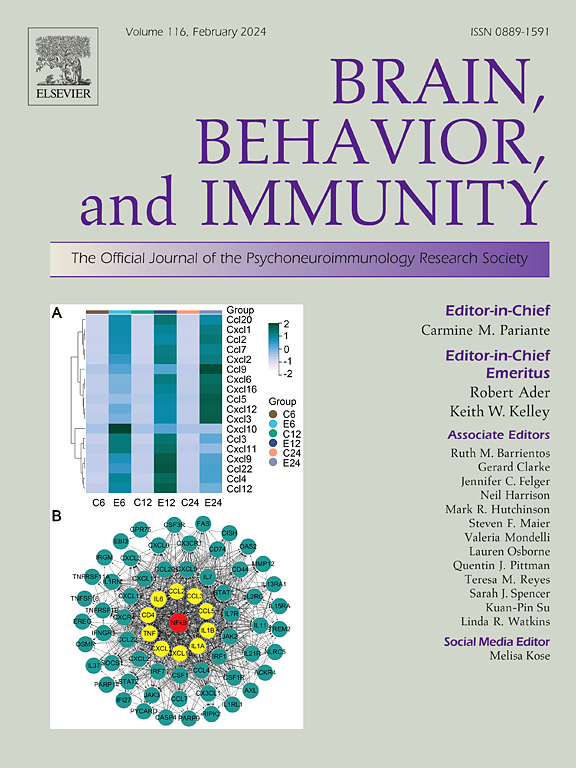Decreased neutrophil-to-lymphocyte ratio predicted cognitive improvement in late-life depression treated with vortioxetine: Findings from an eight-week randomized controlled trial
IF 8.8
2区 医学
Q1 IMMUNOLOGY
引用次数: 0
Abstract
Background
Elevated neutrophil-to-lymphocyte ratio, a marker of inflammation, has been reported in adult and late-life depression. Vortioxetine has shown efficacy in treatment of late-life depression, yet little is known regarding its immunomodulatory role in clinical trials.
Methods
This is a post-hoc analysis of an eight-week randomized controlled trial. Depressed patients aged 65 or above were treated by vortioxetine, duloxetine or placebo. 321 patients that have taken blood tests at baseline and endpoint were included in the analysis. Neutrophil-to-lymphocyte ratio (NLR) was calculated using the absolute counts of each cell type. Cognitive performance was assessed by composite score of Digit Symbol Substitution Test (DSST) and the Rey Auditory Verbal Learning Test (RAVLT) tasks, while depressive symptoms were assessed by Montgomery–Åsberg Depression Rating Scale (MADRS) and Geriatric Depression Scale (GDS).
Results
NLR levels decreased significantly in the entire analysis set (t(320) = 2.64, p = 0.008) and in the vortioxetine group (M = −0.186, t(105) = 2.070, p = 0.041, Cohen’s d = 0.20), but not in the two other groups. This decrease was not significantly different compared to placebo (F(1, 213) = 0.420, p = 0.517). Furthermore, larger NLR changes in vortioxetine arm predicted significant cognitive improvement (β = −4.03, p = 0.03), specifically regarding the DSST correct symbols (β = −1.97, p = 0.04) and RAVLT delayed recall (β = −1.87, p = 0.02) tasks. Additionally, decreased NLR significantly predicted reduced GDS score (β = 1.82, p = 0.02), yet not MADRS score.
Conclusion
Vortioxetine treatment was associated with decreased NLR levels in late-life depression, and reductions in NLR predicted improvements in cognitive function and depressive symptoms, suggesting a potential link between inflammation and clinical outcomes.
求助全文
约1分钟内获得全文
求助全文
来源期刊
CiteScore
29.60
自引率
2.00%
发文量
290
审稿时长
28 days
期刊介绍:
Established in 1987, Brain, Behavior, and Immunity proudly serves as the official journal of the Psychoneuroimmunology Research Society (PNIRS). This pioneering journal is dedicated to publishing peer-reviewed basic, experimental, and clinical studies that explore the intricate interactions among behavioral, neural, endocrine, and immune systems in both humans and animals.
As an international and interdisciplinary platform, Brain, Behavior, and Immunity focuses on original research spanning neuroscience, immunology, integrative physiology, behavioral biology, psychiatry, psychology, and clinical medicine. The journal is inclusive of research conducted at various levels, including molecular, cellular, social, and whole organism perspectives. With a commitment to efficiency, the journal facilitates online submission and review, ensuring timely publication of experimental results. Manuscripts typically undergo peer review and are returned to authors within 30 days of submission. It's worth noting that Brain, Behavior, and Immunity, published eight times a year, does not impose submission fees or page charges, fostering an open and accessible platform for scientific discourse.

 求助内容:
求助内容: 应助结果提醒方式:
应助结果提醒方式:


